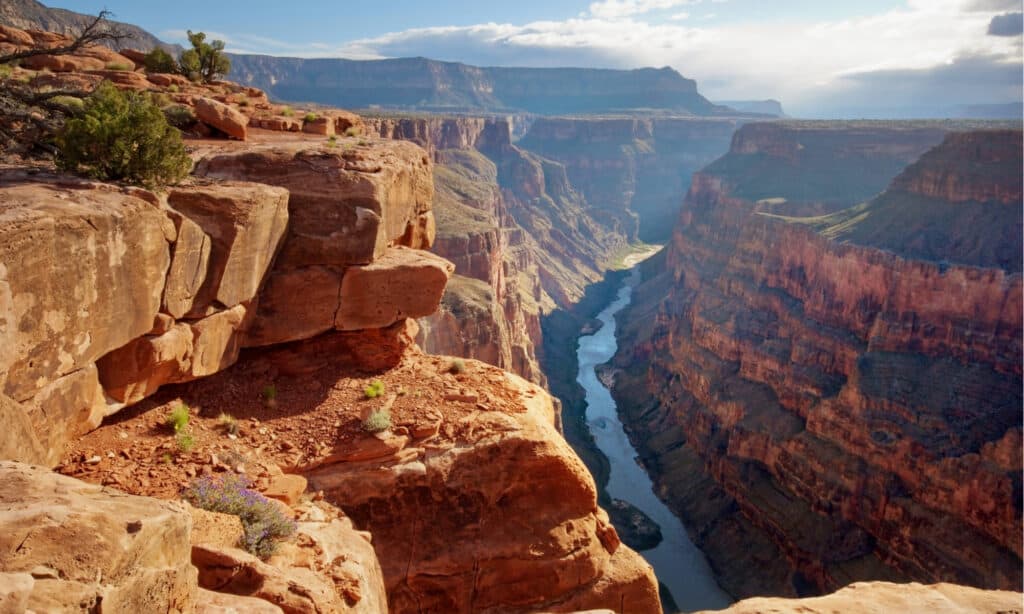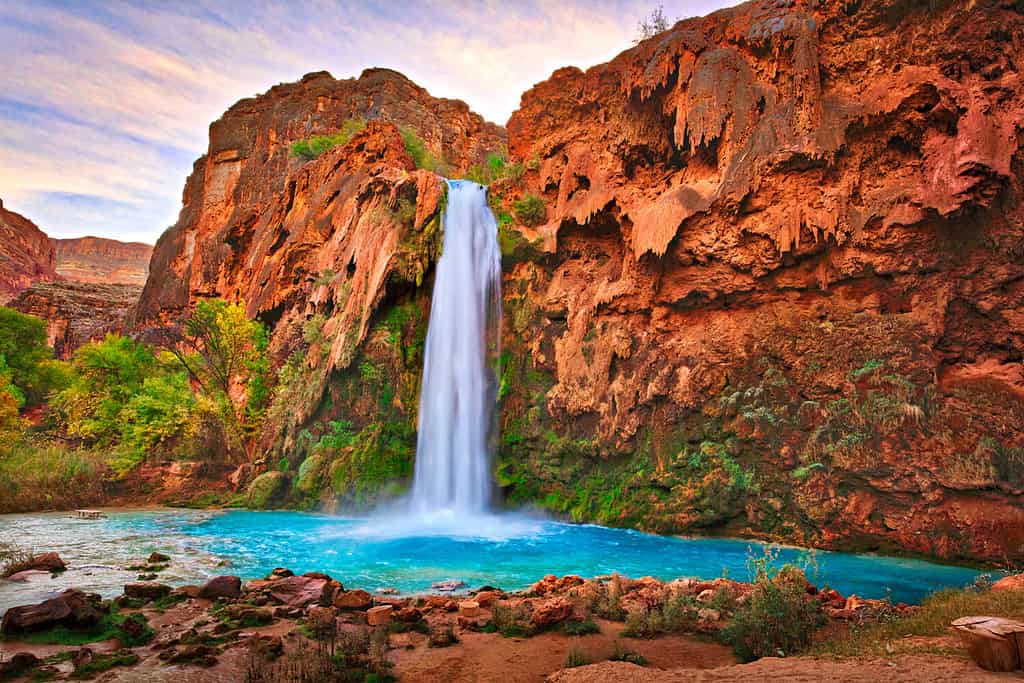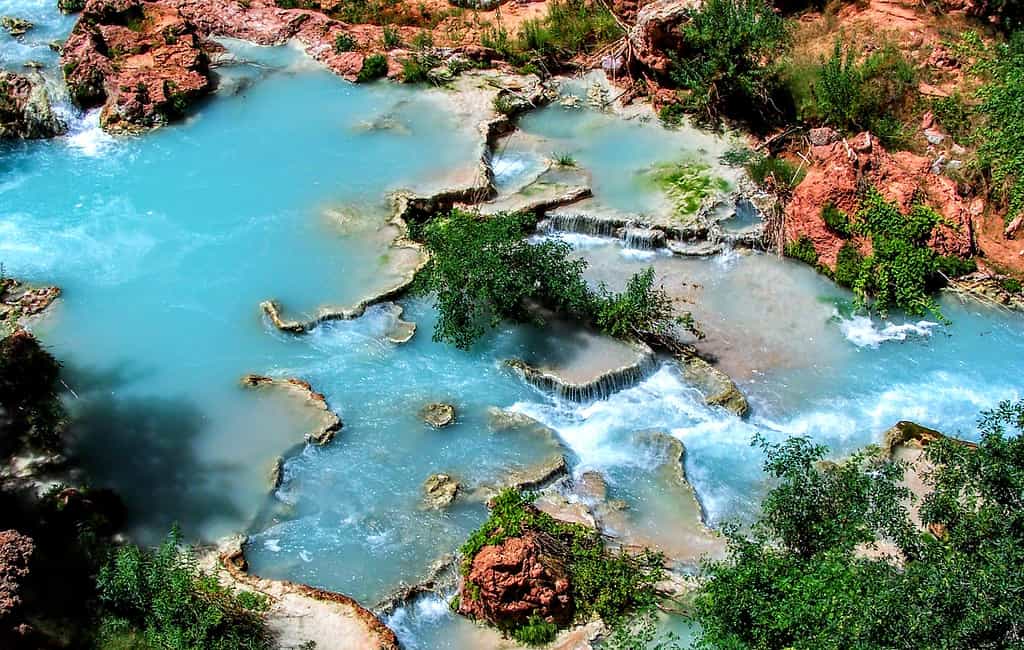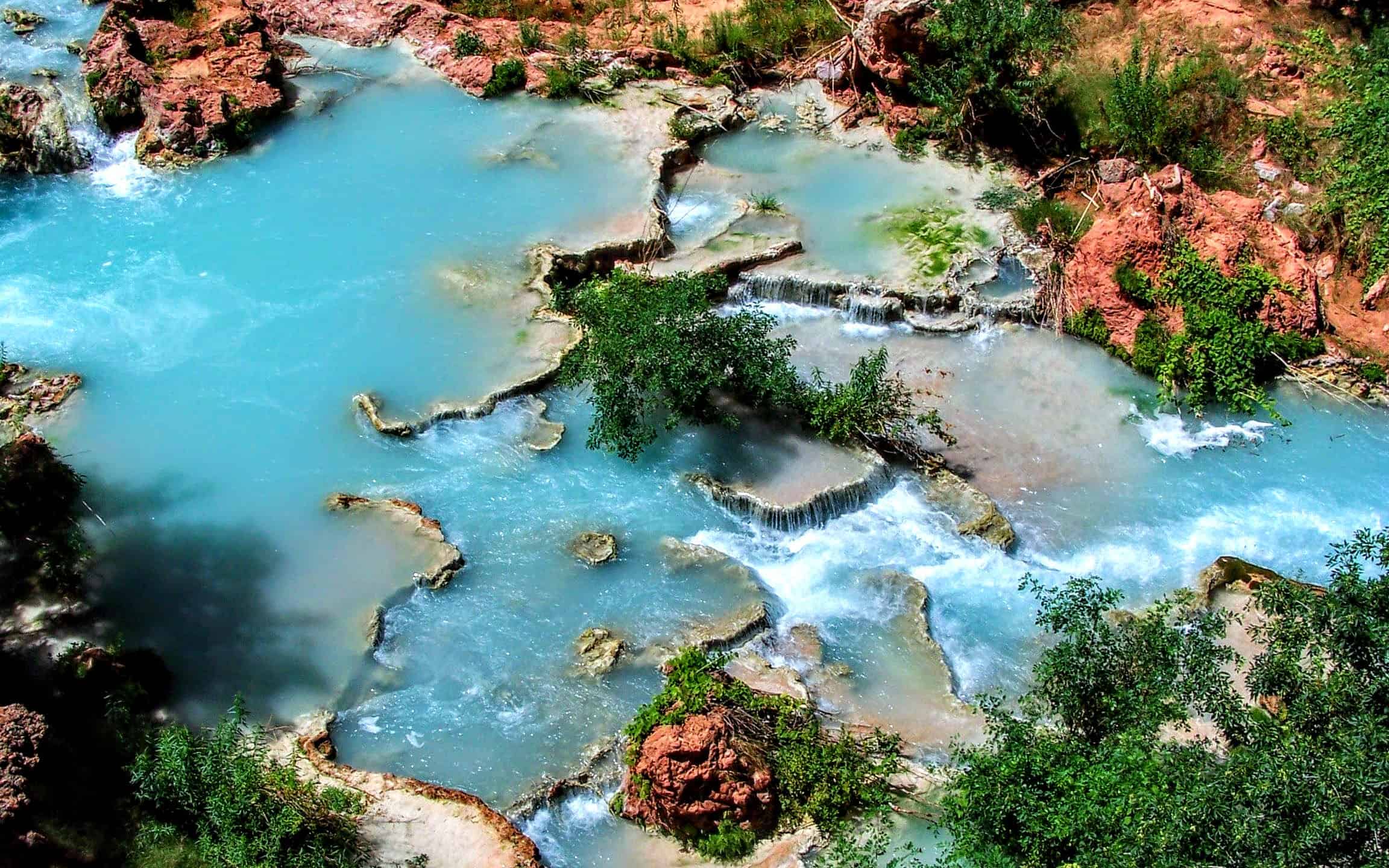With more than 90,000 miles of rivers, streams, and creeks throughout Arizona, you’re bound to find some incredible places to plunge in for a swim on one of those insanely hot summer days. But what about when you’re visiting the Grand Canyon? Is swimming permitted? Are there any Grand Canyon swimming holes?

Thankfully, there are these amazing choices to consider as you hike your way through the massive canyon.
Time to dive in for a cool, refreshing swim and beat that crazy heat!
Tips for Visiting the Best Grand Canyon Swimming Holes

The Grand Canyon isn’t just a Wonder of the world. It’s also home to a variety of bodies of water, including waterfalls, rivers, and creeks. And, in some cases, the best swimming around.
©sumikophoto/Shutterstock.com
Grand Canyon swimming holes require fairly significant hikes to reach them, as the bodies of water are down in the Canyon, not on the rim. You should prepare for these swimming holes with proper safety in mind.
- Bring plenty of drinking water. 1 gallon per person is recommended as the minimum per day of wilderness activity.
- Wear proper hiking gear. Don’t set out in your swimsuit and flip-flops. Instead, wear proper footwear (ideally hiking boots), temperature-appropriate clothing, and a hat.
- Apply sunblock. Carry extra with you for re-application throughout your hike.
- Pack plenty of snacks. You’ll want to bring along snacks that provide you with protein and electrolytes without spoiling. Suggestions include salted trail mix, granola bars, and electrolyte water additives.
- Bring emergency equipment. You should have your GPS-enabled smartphone or other device. Bring along a small first aid kit, as well. A warm jacket or emergency blanket is also a good idea.
- If possible, pack a solar power bank. This will allow you to recharge your devices without needing to plug in.
- You may wish to bring rock climbing equipment, as some of the Grand Canyon swimming holes involve a bit of scrambling.
Be sure to let your friends or family know that you are hiking in these remote locations. Make sure your phone is in tracking mode (i.e., turned on, not airplane mode), and keep your device charged. Avoid overusing your phone to keep the charge up.
1. Havasu Falls

Check out that incredible turquoise water! Havasu Falls are not only breathtaking, but they’re a great place to swim in the Grand Canyon.
©LHBLLC/Shutterstock.com
Perhaps the most popular of all the swimming holes in the state, Havasu Falls not only offers that refreshing cool water you crave but a stunning view to boot. The falls may only be reached by a strenuous hike, though, so when you get there, you may be ready for a brief nap before you plunge in. Be sure to carry plenty of drinking water, snacks, and emergency gear for your safety.
The falls splashing down the stunning waters into turquoise pools find home within the Grand Canyon. The echoing roar of the waters keeps you hiking to them until you’re ready to plunge in. But there are some things to keep in mind as you head there.
Firstly, every visitor to Havasu Falls requires a permit. The reason? Havasu Falls resides within First Nation territory. This means that every person entering requires a pass – and there’s no way to sneak into the area. Many rangers patrol the terrain to help keep the land and its people safe.
You may receive permits one of two ways.
- Reserve a campsite in the Havasupai Campgrounds. Reservations open February 1, 8 am Arizona time. Visit the website for more information. The reservations vanish quickly, though, so create your account ahead of time and plan to log in immediately on the day to increase your chances of booking a site.
- Book lodging at the Havasupai Lodge. These bookings go on sale June 1 and may only be made via telephone at 928-448-2111 or 928-448-2201.
Please note that drones and alcohol are strictly prohibited in the area and may result in hefty fines or even prison time.
2. Beaver Falls

Beaver Creek Falls Arizona is on the Havasupai reservation. To hit up this incredible swimming hole in the Grand Canyon, you’ll need a permit.
©iStock.com/Jeremy Christensen
Also located within the Havasupai Reservation, Beaver Falls may be one of the most underrated swimming holes in the United States. The stunning waterfall lies within the Grand Canyon in remote regions. The trailhead may be found 60 miles out along Indian Route 18. Wild horses, on occasion, may be spotted along the road, but otherwise, you’re unlikely to see much of anything.
You’ll find the waterfall after a three-mile nature hike from the Hualapai Hilltop trailhead, out from the Havasupai campground.
As with Havasu Falls, entry to Beaver Falls required a permit. Day hiking in the land is completely prohibited, so to enjoy this Grand Canyon swimming hole, you’ll need to enjoy some camping or the Havasupai Lodge, as well.
Make your reservations for the Lodge or camping grounds as mentioned above. These provide your permits. However, it’s always a good idea to double-check what each permit allows.
The waterfall pools into what hikers have described as a “tiny water oasis” with incredibly clear water. You’ll pass through a tunnel and find the palm trees and waterfall calling your name. To make it down to the pool, you’ll need to descend from the peak of Beaver Falls downward, straddling the canyon wall.
3. Navajo Falls

Navajo Falls in the Grand Canyon once shared one cascade. Now, after a massive mudslide, the falls have been split. They still remain one of the most amazing Grand Canyon swimming holes, though!
©Jimmy W/Shutterstock.com
Upper Navajo Falls
A comparatively uncrowded swimming hole, Upper Navajo Falls offers a beautiful, cozy pool for relaxation. Falling 50 feet, with a cave for swimming through behind the waterfall, and stunning cascades draw visitors looking for a more secluded swim. While many do jump from the nearby rocks, this is not actually permitted and dangerous. So, if you make your way there, avoid following suit and maintain healthy practices.
Also known as New Navajo Falls, the spot may be reached by passing through the Supai village on the way to the campground. The near Grand Canyon swimming hole is located off the main trail, requires a little climbing to reach, and is also on First Nations land. This means that you will need a permit to visit the swimming hole, along with proper hiking gear, and safety equipment.
The hike is a multi-day adventure, at about 18 miles round-trip. Experienced hikers consider the trail moderate to hard and say it should be avoided after heavy rainfall. Though the waterfall isn’t technically in the Grand Canyon, it lies within Havasu Canyon nearby and may be reached on foot by way of the Havasu trail that begins within the Grand Canyon on the Havasu Falls Trail.
Hiking season for the falls runs between February and November, with the trail often closed from June to August due to flooding or extreme heat.
Lower Navajo Falls
Originally, Navajo Falls contained a single waterfall. However, in 2008, a mudslide after a flash flood divided the falls and created the second waterfall. Lower Navajo Falls resides most closely to the original falls, so the newly shifted fall is, at times, called the Little Navajo Falls versus Upper Falls which are the “newer” falls. The dual falls source their name from an old Supai chief.
The cascades of Lower Navajo Falls drop approximately 30 feet, ending in a glorious pool of turquoise, crystal water. The waterfall rests near Upper Navajo Falls, so the same hiking trail provides access to the Falls. This means you get a beautiful two-for-one adventure and double-swimming-hole-day-out.
You’ll reach Navajo Falls first along the trail from the Supai Village as you descend Havasu Creek.
4. Mooney Falls

Mooney Falls in the Grand Canyon invites swimmers with its incredible beauty, vivid waters, and unique location. You’ll need a permit to enter, though!
©Juancat/Shutterstock.com
The final waterfall on our list goes by the name Mooney Falls. The stunning waterfall is nearly as impressive as the more famous Havasu Falls and happens to be both the highest and most waterfall in Havasupai. You’ll need to hike the trail out (permits are required for this one, as well!) and climb down using chains and ladders. This waterfall swimming hole welcomes visitors of various hiking skill levels, but most recommend intermediate and advanced hikers only should visit.
The waterfall resides within a shadier spot than the others, meaning the water is a bit cooler, but on a hot Arizona day, who’s complaining? You may enjoy swinging out over the water on the rope swing or floating in any of the multiple pools at the falls.
Summary of the 4 Best Grand Canyon Swimming Holes
| Swimming Hole | Hike Difficulty | |
|---|---|---|
| 1 | Havasu Falls | Strenuous, permit required from Havasupai Reservation |
| 2 | Beaver Falls | 3-mile hike, permit required from Havasupai Reservation |
| 3 | Navajo Falls | Hard, 18-mile hike, permit required from Havasupai Reservation |
| 4 | Mooney Falls | Difficult, requires chains and ladders, permit required from Havasupai Reservation |
Thank you for reading! Have some feedback for us? Contact the AZ Animals editorial team.








